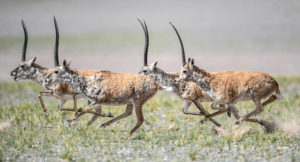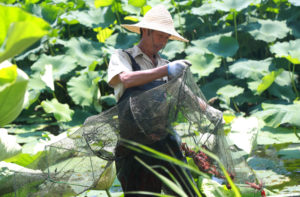The world has failed to fully meet any of the targets agreed by world leaders to arrest the steep decline of nature by 2020, according to a final report by the United Nations’ Convention on Biological Diversity (CBD), which warned that the result put “humanity at a crossroads”.
The 20 targets set by the CBD in 2010 in Aichi, Japan, aimed to tackle the drivers of biodiversity loss, including from deforestation, unsustainable agriculture, pollution, habitat loss, and invasive species, while increasing protected areas, public awareness, scientific knowledge and integration of biodiversity into policymaking.
An interim report by the CBD in 2014 warned that progress was insufficient, and the final report has confirmed that, out of 60 criteria against which success under the targets was measured, only 38 show any improvement, while 13 show no progress at all, or a deterioration. The level of progress for two elements was unknown, leaving seven that had been achieved.
The report – Global Biodiversity Outlook 5 (GBO5) – was released to coincide with virtual meetings under the CBD to negotiate new targets to be agreed in Kunming, China in May. Scientists and conservation bodies have increased their calls for urgent action by governments in the face of new evidence on the precipitous deterioration of the natural world.
Steep declines in biodiversity
Wildlife populations have declined by two thirds on average since 1970, according to the latest assessment by WWF and the Zoological Society of London, which brings together research on more than 4,000 vertebrate species from more than 125 experts around the world. Deforestation, unsustainable agriculture and the illegal wildlife trade are major causes, all of which also contribute to outbreaks of viruses like Covid-19, the researchers said.
One million
species, around an eighth of the estimated total of animal and plant species, are at risk
Wildlife declines highlighted in the Living Planet Index include the eastern lowland gorilla, whose numbers in one national park in the Democratic Republic of Congo fell by 87% in 20 years due to illegal hunting, and the African grey parrot in Ghana, which suffered a 99% decline in just over 20 years due to the wild bird trade and habitat loss. Worst hit were wildlife populations in freshwater habitats, with an 84% average population decline since 1970, scientists found.
There are multiple reasons why the Aichi targets did not arrest these declines, but a lack of strong implementation and investment underlined many of these. Outlining a vision without ensuring robust implementation, would result in “nothing but empty promises”, and the CBD report has confirmed this, said Li Shuo, global policy advisor of Greenpeace East Asia.
“The 2010 Aichi decisions were a batch of orphaned targets, never actively owned by most of the parties, let alone supported with necessary resources,” he added.
Under the CBD, countries can establish their own plans for implementation against national targets. They then submit progress reports to the CBD secretariat for assessment. However, the CBD judged around three quarters of national targets to be poorly aligned with the Aichi targets in terms of scope and ambition. Only around a tenth of all national level targets are both similar to Aichi, and on track to be met, the CBD said.
The Chinese government’s report states that the country is on track to achieve 13 of its targets, and would exceed on a further three. Despite flagging overexploitation of natural resources, climate change, pollution, loss of habitat and invasive species as threats to its biodiversity, it judged that it had made insufficient progress only on invasive species, vulnerable ecosystems and preventing extinctions.
Globally, the CBD judged six out of the 20 Aichi targets to have been partially met. Successes include work to eradicate invasive mammals on islands, which has benefited native species. However, this represented only a small proportion of invasive species, and there was no evidence that the number of new introductions was slowing, it noted.
A target to designate at least 17% of terrestrial and inland water areas, and 10% of marine and coastal areas as protected areas was likely to be met, and could even be exceeded when future commitments were taken into account. However, countries had not necessarily protected the most important areas for biodiversity, nor ensured that they were ecologically representative, and connected to one another and the wider land or seascape, or effectively managed, the CBD said.
Countries had in the main achieved a goal to implement policies under a national biodiversity strategy and action plan, with 85% of signatories to the CBD achieving this. However, the report noted that governments had a variable track record in implementing the strategies effectively.
Similarly, significant progress had been made against a goal to generate and share knowledge and data on biodiversity, but the CBD found that application of this knowledge in decision making was limited.

Meanwhile, financial resources and official development assistance for biodiversity had roughly doubled. However, this level was not only insufficient, but completely swamped by subsidies for activities harmful to biodiversity such as unsustainable agriculture, overfishing and use of pesticides and fossil fuels.
Relatively few governments have even identified such subsidies, the CBD noted. Total finance for biodiversity from the public and private sectors is estimated at about $80-90 billion per year, while harmful subsidies are estimated at around $500 billion. Subsidies for production of commodities linked to forest destruction in Brazil and Indonesia were estimated to exceed the amount spent on measures to combat deforestation.
While deforestation was found to have been reduced by around a third compared with the previous decade, the CBD found that it might be accelerating again in some areas, and that degradation and fragmentation of habitat in forest remained high, especially in the most biodiversity-rich ecosystems in tropical regions.
Overall, the CBD judged that species continued to move closer to extinction. One million species, around an eighth of the estimated total of animal and plant species, are at risk, according to scientists on the Intergovernmental Science-Policy Platform on Biodiversity and Ecosystem Services (IPBES). However, the CBD flagged that, without the efforts of conservation projects over the past decade, the number of extinctions of birds and mammals would likely have been at least two to four times higher.
Lessons for the Kunming talks
Campaigners are not optimistic that negotiations on a new global agreement to protect nature are taking into account lessons from the failure of the Aichi goals. Most of the discussion so far has been invested in designing the next set of targets – to protect at least 30% of land and seas – at the expense of implementation and finance, Li notes.
Linda Krueger, senior policy advisor for The Nature Conservancy, agreed: “This report is additional confirmation that half-hearted measures and hopeful thinking are not enough. We need transformative, urgent changes to our policies, financial flows and behaviour if we want to protect the natural world that all of us depend on.”
There had been a global failure on the Aichi targets, and lessons needed to be learned from how they had been agreed, admitted Inger Anderson, executive director of the UN Environment Programme during a press conference to launch GB05. Whole governments needed to be involved in protecting biodiversity, not just environment departments, but also those governing agriculture, infrastructure and fisheries, she said.
“That was not the case last time, many government departments were not aware of the commitments that had been made,” she said.
CBD executive secretary, Elizabeth Maruma Mrema said that the secretariat had a specific programme to mainstream biodiversity across governments. “We have seen more and more government departments involved and engaged,” she said.
Deputy executive secretary of the CBD David Cooper said that heads of state needed to take charge, to make sure that the agenda was not expected to be pushed solely by environment ministries. The CBD was working with other ministries through other UN bodies such as the World Health Organisation and the Food and Agriculture Organization, but needed to do more to engage finance and economic development ministries, he said.
Urgent action needed
The GB05 report lists eight areas where action needs to be focussed. The impact of land use change could be mitigated through conservation and restoration of ecosystems and the use of landscape-level planning, it said; while agricultural systems need to be redesigned to enhance productivity while minimising damage to biodiversity and diets should be more plant-based, as well as bring about dramatic cuts in food waste.
Marine and coastal ecosystems should be protected and restored; while nature should be encouraged in cities through the deployment of green infrastructure; the quality of freshwater should be improved and invasive species controlled; nature-based solutions could simultaneously mitigate climate change and benefit biodiversity; and the health of both people and nature could be improved through ecosystem management, it states.
Crucially, all these areas of action needed to be taken together to ensure success, it said, for example, conserving ecosystems will not prevent biodiversity loss unless equally ambitious steps were taken to adopt more sustainable diets. Combining actions will also make each easier to achieve, due to the synergies between them, the CBD said.
Anderson said that economic stimulus packages being drawn up by governments to rescue economies battered by the Covid-19 pandemic presented a real opportunity to mainstream nature protection. She gave the example of Pakistan, which was paying the unemployed to plant trees as part of its existing 10 Billion Tree Tsunami programme.
Krueger agreed: “This is not a hopeless cause, and GBO5 does highlight the areas where tangible, meaningful progress has been made. There are some bright spots, and now is the time to seize that potential. As governments all around the world pump trillions of dollars into economic packages, let’s put nature and the climate at forefront of recovery.”









